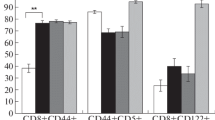Abstract
Specific suppressor T cells (SSTC), primed in vivo with H-2 antigens, have been shown previously to inhibit DNA synthesis in the one-way, three-cell mixed lymphocyte reaction (MLR) provided that (a) the stimulator cells bear the priming H-2 antigens, and (b) the responder cells possessIC+S regions homologous to those of the SSTC. Anti-B10.A BlO.A(2R) SSTC (anti-Dd) and anti-A.AL A.TL SSTC (anti-Kk) are shown here to be able to inhibit the DNA synthesis triggered in MLR, not only by the corresponding antigens, Dd and Kk, respectively, but also by irrelevant, third-party H-2 and Mls products provided that the corresponding and third-party antigens are presented on the same stimulator cell. If stimulatorH-2 regions, whose products interact with SSTC and responders, are located on different stimulator cells within the particular MLR, SSTC activity is not elicited. Participation of cytotoxic T lymphocytes in DNA-synthesis suppression is ruled out. Direct contact or location of the inhibited responder cell very close to SSTC is considered to be required for the development of SSTC activity.
Similar content being viewed by others
References
Al-Adra, A. R. and Pilarski, L. M.: Antigen-specific suppression of cytotoxic T cell responses in mice. I. Suppressor T cells are not cytotoxic cells.Eur. J. Immunol. 8: 504–511, 1978
Bach, F. H., Bach, M. L., and Sondel, P. M.: Differential function of major histocompatibility complex antigens in T-lymphocyte cultivation.Nature 259: 273–281, 1976
Brondz, B. D., Karaulov, A. V., and Abronina, I. F.: Evidence for receptors of the specific T suppressor cells immune to the H-2 antigens, and enrichment of these cells by fractionation on target cell monolayer.Mol. Biol. (Mosk.) 13: 1287–1295, 1979
Brondz, B. D., Karaulov, A. V., and Abronina, I. F.: Immunological specificity and kinetics of T-cell suppressor induction by immunization of mice with allogeneic spleen cells.Cytologia (Leningrad) 22: 583–590, 1980a
Brondz, B. D., Karaulov, A. V., Abronina, I. F., and Blandova Z. K.: Biological, immunological and genetic characterization of specific suppressor T cells and their receptors immune to antigens of the H-2 complex. Clonal structure, narrow specificity of receptors and genetic restriction of specific T-suppressor function.Mol. Immunol. 17: 833–849, 1980b
Brondz, B. D., Karaulov, A. V., Abronina, I. F., and Blandova, Z. K.: Requirements for induction of specific suppressor T cells and detection of their H-2 antigen-binding receptors by fractionation on target cell monolayers.Scand. J. Immunol. 13: 517–534, 1981a
Brondz, B. D., Abronina, I. F., Zajceva M. B., and Blandova, Z. K.: la-antigens as markers of specific suppressor T cells immune to antigens of the II-2 complex.Genetika (Mosk.) in press, 1981b
Czitrom, A. A., Sunshine, G. H., and Mitchison, N. A.: Suppression of the proliferative response toH-2D by I-J-subregion gene products.Immunogenetics 11: 97–102, 1980
Eisenthal, A., Nachtigal, D., and Feldman, M.: Induction of allospecific suppressor T cells in vitro.Cell. Immunology 34: 112–124, 1977
Glick, J. L., Lockwood, C., Williams, J., Papermaster, B. W., Burns, A. A. and Dutton, A. C.: Human serum as an economical substitute for foetal bovine serum in lymphoid cell cultures.Transplantation 18: 86–92, 1974
Guttman, R. D.: Mixed leucocyte interactionsuppression generated after alloimmunization.Transplantation 24: 316–324, 1977
Matossian-Rogers, A. and Festenstein, H.: Generation of suppressor cells in mice immunized with M locus-incompatible lymphocytes.Transplantation 23: 316–321, 1977
Möller, G. (ed.):Suppressor T lymphocytes. Transplantation Reviews, Volume 26. Munksgaard, Copenhagen, 1975
Orosz, C. G. and Bach, F. H.: Alloantigen-activated CML suppression independent of cytotoxic activity.J. Immunol. 123: 1419–1421, 1979
Paul, W. E. and Benacerraf, B.: Functional specificity of thymus-dependent lymphocytes.Science 195: 1293–1299, 1977
Rich, S. S. and Rich, R. R.: Regulatory mechanisms in cell-mediated immune responses. III. I-region control of suppressor cell interaction with responder cells in mixed lymphocyte reactions.J. Exp. Med. 143: 672–685, 1976
Rich, S. S., David, C. S., and Rich, R. R.: Regulatory mechanisms in cell-mediated immune responses. VII. Presence of I-C subregion determinants on mixed leukocyte reaction suppressor factor.J. Exp. Med. 149: 114–126, 1979
Rich, S. S. and David, C. S.: Regulatory mechanisms in cell-mediated immune responses. VIII. Differential expression of I-region determinants by suppressor cells and their targets in suppression of mixed leukocyte reactions.J. Exp. Med. 150: 1108–1121, 1979
Snell, G. D.: T cells, T cell recognition structures, and the major histocompatibility complex.Immunol. Rev. 38: 3–69, 1978
Suslov, A. P., Eliseeva, L. S., Brondz, B. D., Abronina, I. F., and Chervonsky, A. V.: Effect of thymectomy and adrenalectomy of adult animals, as well as of serotonin on the functional activities of T lymphocytes immune in vivo and in vitro to antigens of the H-2 complex.Immunology (Mosk.) 1: 74–79, 1980
Truitt, J. A., Rich, R. R., and Rich, S. S.: Regulation of cytotoxic lymphocyte responses in vitro by alloantigen-activated spleen cells.J. Immunol. 119: 31–37, 1977
Turkin, D. and Sercarz, E. E.: Key antigenic determinants in regulation of the immune response.Proc. Natl. Acad. Sci. U.S.A. 74: 3984–3987, 1977
Wagner, H., Starzinski-Powitz, A., Pfizenmaier, K., and Röllinghoff, M.: Regulation of T cell-mediated cytotoxic allograft responses. I. Evidence for antigen-specific suppressor T cells.Eur. J. Immunol. 6: 873–878, 1976
Author information
Authors and Affiliations
Rights and permissions
About this article
Cite this article
Brondz, B.D., Karaulov, A.V., Chervonsky, A.V. et al. Requirement for the location of both appropriate and irrelevant H-2 antigens on the same stimulator cell for unspecific DNA-synthesis inhibition by the H-2-antigen-primed, specific suppressor T cells. Immunogenetics 15, 167–176 (1982). https://doi.org/10.1007/BF00621949
Received:
Revised:
Issue Date:
DOI: https://doi.org/10.1007/BF00621949




